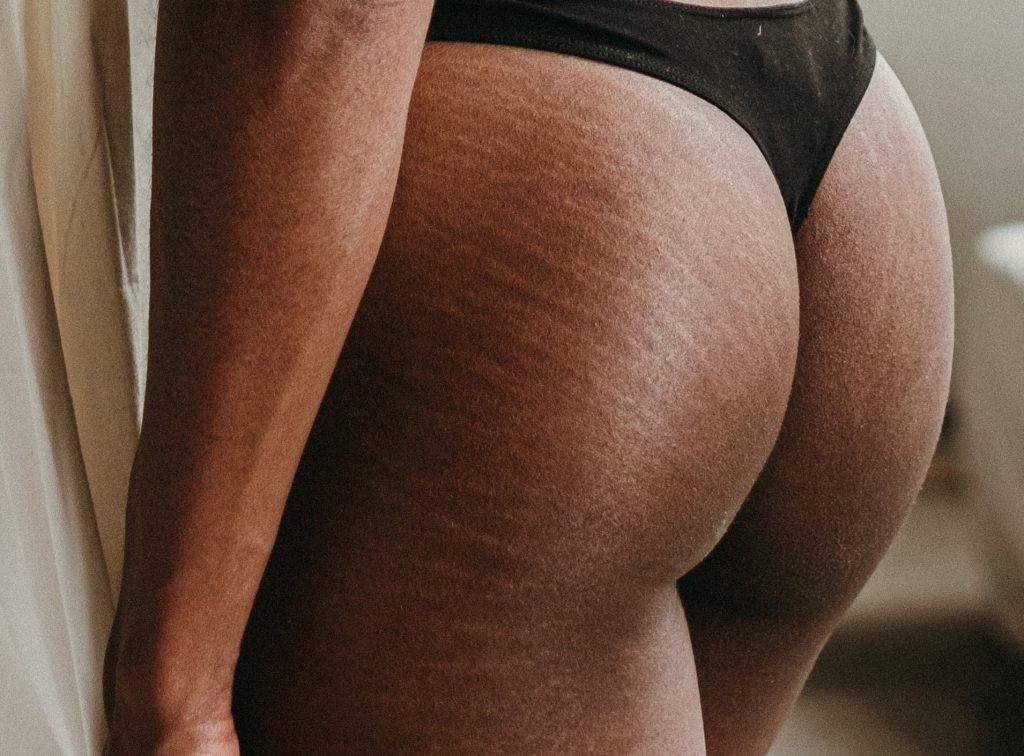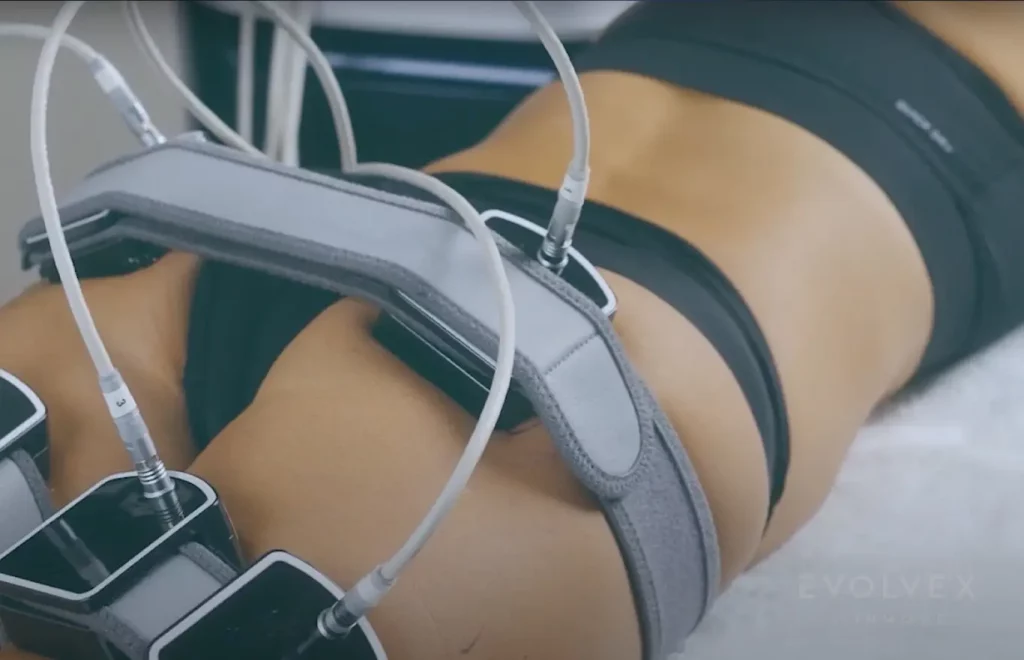I often get asked what I can do about cellulite and stretch marks? As it happens quite a lot! But before I go into the solutions let’s look at the causes. One of the first things I’ll say is they’re 100% normal and natural. We all have them or get them at some point in our lives.That said sometimes they can be more complex than at others and can cause self-esteem and confidence issues.
When the skin ages it develops laxity due to the deteriorating levels of collagen and elastin in the skin. This causes weak points where breaks can appear. Cellulite usually looks like lumpy, cottage cheese bumps and is caused by deposits of fatty tissue poking though these weak points. There are usually bands that anchor the various layers of tissue and skin to each other and when everything gets lax, the fat pokes upwards and puckering occurs. Stretch marks look like very fine red or silver tears in the skin. Often they are caused by rapid growth or shrinking of the skin and happen during puberty or childbearing. These marks are often permanent and scar-like and are usually found on areas around the stomach, hips, breasts and thighs.
Sometimes hormones and lifestyle choices can contribute to cellulite but they can appear in even the thinnest of women. So what to do?
1. Improve your diet, drink plenty of water, cut out caffeine and alcohol and eat lots of vitamin C rich foods.
2. Use exfoliators such as retin-A or chemical peels to increase cell turnover for increasing collagen
3. Start a course of Morpheus8 RF Microneedling, SkinPen to amp up collagenesis
4. Take collagen supplements to rebuild the skin from the inside
5. Start exercising to tone up the muscle underneath and reduce fat layers that push out cellulite. EvolveX Transform will tone and reduce fat
6. Have plasma using your own stem cells and growth factors to kickstart collagen repair and follow up with red light therapy
Come in and see us at Invigorate Advanced Aesthetics in Centennial, Colorado for Morpheus8 or RF Microneedling.


 Alexis Pepple2024-03-09Robyn & her team are truly fantastic. They have come up with a whole skin care routine for me. I love knowing that I have a plan to accomplish the skin care goals that I want. I also love their new membership program. It is such a great value I would highly recommend.
Alexis Pepple2024-03-09Robyn & her team are truly fantastic. They have come up with a whole skin care routine for me. I love knowing that I have a plan to accomplish the skin care goals that I want. I also love their new membership program. It is such a great value I would highly recommend. Alanna Rohloff2024-03-01I’m feeling as motivated as ever to build muscle and lose body fat, working with Caitlin as my nutritionist and coach. She’s so smart and kind. I also love going into the med spa- it’s beautiful and comfortable. Highly recommend this company to anyone.
Alanna Rohloff2024-03-01I’m feeling as motivated as ever to build muscle and lose body fat, working with Caitlin as my nutritionist and coach. She’s so smart and kind. I also love going into the med spa- it’s beautiful and comfortable. Highly recommend this company to anyone. Elexis Zamora2024-02-26Robyn was Great! She answered all of my questions she was professional and listened to what I wanted my results to be. I got Botox and lip filler. I’m currently four days out and I can see results but still waiting on the Botox to kick in! But overall a clean environment cute spa! And so far I love the way my lips turned out. Great experience!!!
Elexis Zamora2024-02-26Robyn was Great! She answered all of my questions she was professional and listened to what I wanted my results to be. I got Botox and lip filler. I’m currently four days out and I can see results but still waiting on the Botox to kick in! But overall a clean environment cute spa! And so far I love the way my lips turned out. Great experience!!! vibes amanda2024-02-24The work I’ve had done here was truly life changing. Aside from the clinic being so inviting and extremely elegant, the staff is so kind and beyond talented. I’ve gotten my lips done here twice now and both times I’ve gained a new found confidence that has made all the difference in the world in my day to day life. This is the greatest investment I’ve ever made into how I feel about myself and I will continue to get all of my aesthetic work done here. I cannot recommend this place enough!
vibes amanda2024-02-24The work I’ve had done here was truly life changing. Aside from the clinic being so inviting and extremely elegant, the staff is so kind and beyond talented. I’ve gotten my lips done here twice now and both times I’ve gained a new found confidence that has made all the difference in the world in my day to day life. This is the greatest investment I’ve ever made into how I feel about myself and I will continue to get all of my aesthetic work done here. I cannot recommend this place enough! Vicious Vanity Ink Tattoo Studio2024-02-23Caitlin is absolutely amazing! She is very helpful and extremely knowledgeable! She is super supportive and is there to help you every step of the way! I highly recommend Caitlin to assist you in all your wellness and nutritional needs!
Vicious Vanity Ink Tattoo Studio2024-02-23Caitlin is absolutely amazing! She is very helpful and extremely knowledgeable! She is super supportive and is there to help you every step of the way! I highly recommend Caitlin to assist you in all your wellness and nutritional needs! Nikki Cox2024-02-23Do it! You'll love how you look after!
Nikki Cox2024-02-23Do it! You'll love how you look after! Ashley Campbell2024-02-22Everyone at Invigorate is so welcoming and kind. I got a facial with Robyn and she was wonderful and my face feel nice and fresh. Excited to continue to go back back for my other skin care needs.
Ashley Campbell2024-02-22Everyone at Invigorate is so welcoming and kind. I got a facial with Robyn and she was wonderful and my face feel nice and fresh. Excited to continue to go back back for my other skin care needs. Kathy Coffey2024-02-22Wonderful experience
Kathy Coffey2024-02-22Wonderful experience Jenny D2024-02-20Amanda is amazing and made me feel so welcome and cared for!Google rating score: 5.0 of 5, based on 111 reviews
Jenny D2024-02-20Amanda is amazing and made me feel so welcome and cared for!Google rating score: 5.0 of 5, based on 111 reviews
Site navigation
Office hours
Appointments outside these hours available upon request
Monday to Friday – 9am – 6pm
Saturday – closed
Sunday – closed